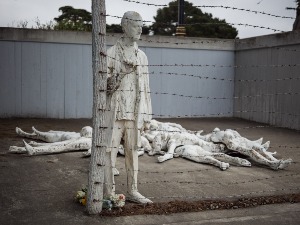
The word "Holocaust" comes from a Greek word and can be divided in "holos" (wholes) and "kaustos" (burned). It was historically used to describe a sacrificial offering burned on an altar. Since 1945, this word has taken a whole new and terrible meaning - the mass murder of over 6 million European Jews and many other members of persecuted groups. Those groups included homosexuals, gypsies, Jehovah's Witnesses, and other religious groups. This was caused by the German Nazis, who ruled during World War II.
Prejudice against Jews didn't start with Adolf Hitler. There had been evidence of hostility toward Jews long before the Holocaust – such as when Roman authorities destroyed the Jewish temple of Jerusalem. Jews were forced to evacuate Palestine. During World World I, prejudice against Jews suffering took on a racial character rather than a religious one. Hitler served in the German army in World War I and he, with many others, blamed the Jews for the country's defeat in 1918. Hitler joined the National German Worker's Party, which later became the National Socialist German Worker Party, also known to Americans as the Nazis. Hitler later became obsessed with the idea of the superiority of the “pure” German race, which he called “Aryan” (meaning in English a non-Jewish Caucasian).
By September 1939, the German army occupied the western half of Poland. German police soon forced tens of thousands of Polish Jews from their homes and into ghettoes, which were surrounded by high walls and barbed wire. The ghettoes functioned like captive city-states and were governed by Jewish councils. In addition to widespread unemployment, poverty, and hunger, overpopulation made the ghettoes breeding grounds for diseases such as typhus - a bacterial disease spread through contaminated food, water, or close contact. Typhus was called "jail fever" to Germans.
In the fall of 1939, Nazis chose around 70,000 Germans institutionalized for disabilities and/or mental illness to be gassed in the Euthanasia program. By 1945, some of 275,000 people judged handicapped from all over Europe had been killed.
The death camps and the ghettoes were different because one was worse than the other one. The ghettoes were in the city and they had food and water, and the people living in them worked in the companies to make better things for Germany during the war. Death camps, also known as concentration camps, would put people to work and treat them poorly; they would have to work until they died.
World War II and the death camps lasted until 1945. Before that, in 1939, Nazis tried to keep the operation of the camps a secret from the Allies, but the size of the killing made that virtually impossible. Germany's formal surrender in World War II came on May 8, 1945. The Holocaust was a horrible and terrifying part of history that should never be repeated.
[Sources:
History.com
;
A Short History of the World
]

